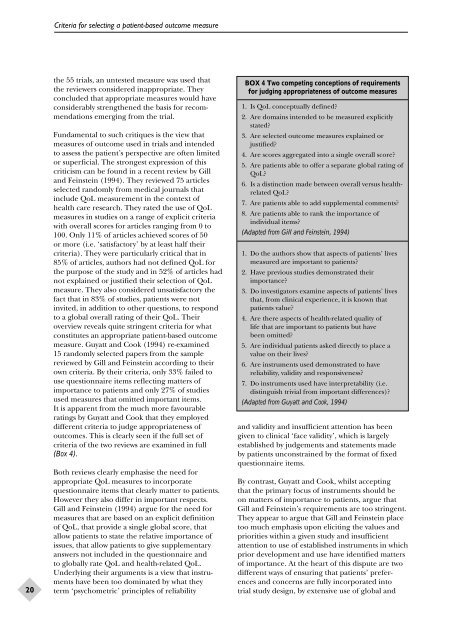Evaluating Patient-Based Outcome Measures - NIHR Health ...
Evaluating Patient-Based Outcome Measures - NIHR Health ...
Evaluating Patient-Based Outcome Measures - NIHR Health ...
Create successful ePaper yourself
Turn your PDF publications into a flip-book with our unique Google optimized e-Paper software.
20<br />
Criteria for selecting a patient-based outcome measure<br />
the 55 trials, an untested measure was used that<br />
the reviewers considered inappropriate. They<br />
concluded that appropriate measures would have<br />
considerably strengthened the basis for recommendations<br />
emerging from the trial.<br />
Fundamental to such critiques is the view that<br />
measures of outcome used in trials and intended<br />
to assess the patient’s perspective are often limited<br />
or superficial. The strongest expression of this<br />
criticism can be found in a recent review by Gill<br />
and Feinstein (1994). They reviewed 75 articles<br />
selected randomly from medical journals that<br />
include QoL measurement in the context of<br />
health care research. They rated the use of QoL<br />
measures in studies on a range of explicit criteria<br />
with overall scores for articles ranging from 0 to<br />
100. Only 11% of articles achieved scores of 50<br />
or more (i.e. ‘satisfactory’ by at least half their<br />
criteria). They were particularly critical that in<br />
85% of articles, authors had not defined QoL for<br />
the purpose of the study and in 52% of articles had<br />
not explained or justified their selection of QoL<br />
measure. They also considered unsatisfactory the<br />
fact that in 83% of studies, patients were not<br />
invited, in addition to other questions, to respond<br />
to a global overall rating of their QoL. Their<br />
overview reveals quite stringent criteria for what<br />
constitutes an appropriate patient-based outcome<br />
measure. Guyatt and Cook (1994) re-examined<br />
15 randomly selected papers from the sample<br />
reviewed by Gill and Feinstein according to their<br />
own criteria. By their criteria, only 33% failed to<br />
use questionnaire items reflecting matters of<br />
importance to patients and only 27% of studies<br />
used measures that omitted important items.<br />
It is apparent from the much more favourable<br />
ratings by Guyatt and Cook that they employed<br />
different criteria to judge appropriateness of<br />
outcomes. This is clearly seen if the full set of<br />
criteria of the two reviews are examined in full<br />
(Box 4).<br />
Both reviews clearly emphasise the need for<br />
appropriate QoL measures to incorporate<br />
questionnaire items that clearly matter to patients.<br />
However they also differ in important respects.<br />
Gill and Feinstein (1994) argue for the need for<br />
measures that are based on an explicit definition<br />
of QoL, that provide a single global score, that<br />
allow patients to state the relative importance of<br />
issues, that allow patients to give supplementary<br />
answers not included in the questionnaire and<br />
to globally rate QoL and health-related QoL.<br />
Underlying their arguments is a view that instruments<br />
have been too dominated by what they<br />
term ‘psychometric’ principles of reliability<br />
BOX 4 Two competing conceptions of requirements<br />
for judging appropriateness of outcome measures<br />
1. Is QoL conceptually defined?<br />
2. Are domains intended to be measured explicitly<br />
stated?<br />
3. Are selected outcome measures explained or<br />
justified?<br />
4. Are scores aggregated into a single overall score?<br />
5. Are patients able to offer a separate global rating of<br />
QoL?<br />
6. Is a distinction made between overall versus healthrelated<br />
QoL?<br />
7. Are patients able to add supplemental comments?<br />
8. Are patients able to rank the importance of<br />
individual items?<br />
(Adapted from Gill and Feinstein, 1994)<br />
1. Do the authors show that aspects of patients’ lives<br />
measured are important to patients?<br />
2. Have previous studies demonstrated their<br />
importance?<br />
3. Do investigators examine aspects of patients’ lives<br />
that, from clinical experience, it is known that<br />
patients value?<br />
4. Are there aspects of health-related quality of<br />
life that are important to patients but have<br />
been omitted?<br />
5. Are individual patients asked directly to place a<br />
value on their lives?<br />
6. Are instruments used demonstrated to have<br />
reliability, validity and responsiveness?<br />
7. Do instruments used have interpretability (i.e.<br />
distinguish trivial from important differences)?<br />
(Adapted from Guyatt and Cook, 1994)<br />
and validity and insufficient attention has been<br />
given to clinical ‘face validity’, which is largely<br />
established by judgements and statements made<br />
by patients unconstrained by the format of fixed<br />
questionnaire items.<br />
By contrast, Guyatt and Cook, whilst accepting<br />
that the primary focus of instruments should be<br />
on matters of importance to patients, argue that<br />
Gill and Feinstein’s requirements are too stringent.<br />
They appear to argue that Gill and Feinstein place<br />
too much emphasis upon eliciting the values and<br />
priorities within a given study and insufficient<br />
attention to use of established instruments in which<br />
prior development and use have identified matters<br />
of importance. At the heart of this dispute are two<br />
different ways of ensuring that patients’ preferences<br />
and concerns are fully incorporated into<br />
trial study design, by extensive use of global and
















